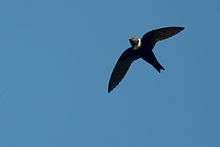White-collared swift
| White-collared swift | |
|---|---|
 | |
| Scientific classification | |
| Kingdom: | Animalia |
| Phylum: | Chordata |
| Class: | Aves |
| Order: | Apodiformes |
| Family: | Apodidae |
| Genus: | Streptoprocne |
| Species: | S. zonaris |
| Binomial name | |
| Streptoprocne zonaris (Shaw, 1796) | |
The white-collared swift (Streptoprocne zonaris) is a resident breeding bird from central Mexico, the Greater Antilles and Trinidad south to Peru, northern Argentina and southeastern Brazil.
This very large swift builds a saucer nest of mud, moss and chitin on a ledge in a cave, usually behind a waterfall, and lays two white eggs between March and July. It breeds in the mountains and foothills, but forages over a much larger area, including lowlands.
Description
White-collared swift is a massive and powerful species, 20–22 cm (8–8.5 in) long, and weighing 90–125 g (3.2–4.4 oz). It is the largest species of swift in its range exceed in southwestern Mexico, where it may co-exist with its slightly larger cousin, the white-naped swift, which is one of the two largest swifts in the world. The white-collared swift has a wingspan of 45 to 55 cm (18 to 22 in).[2] It has a very slightly forked tail, which often appears square. The adults are black, glossed blue on the back, and have a white collar, broader and duller on the breast than the hindneck. Young birds are duller than adults, and the collar is reduced or absent.
Behavior and Ecology
This is a highly gregarious species, with flocks of 100 or more birds, and often in company with other swift species. It has a powerful, fast and direct flight, and will ascend thermals to great heights. White-collared swifts are known to attain or exceed flying speeds of 70 to 100 km/h (43 to 62 mph) despite their relatively large size.[3] This noisy swift has a screeching chee-yar! call, which may be given in chorus by a flock. A flock will also make a "wooshing" sound as their wings beat against the wind.[4]
White-collared swift feeds in flight on flying insects, including beetles, bees and flying ants. This species breeds in April to May, early in the wet season to correspond with a peak number of insect prey, building a cup nest out of mud, moss and reguritated, grounded insect parts (the same matter that is later fed to the nestlings), each nest measuring 120–170 mm (4.7–6.7 in) in diameter with a depths of 30–90 mm (1.2–3.5 in). Nests are located on ledges and nooks along the cave walls. Two eggs are laid and the nesting stage ends when young become independent of their parents at 45–55 days. In Mexico, their only verified predators are Virginia opossums, which raid and eat the young in nests, and peregrine falcons, which are known to wait near colony entrances to pick off birds as they first fly off.[5][6]
References
- ↑ BirdLife International (2012). "Streptoprocne zonaris". IUCN Red List of Threatened Species. Version 2013.2. International Union for Conservation of Nature. Retrieved 26 November 2013.
- ↑ Fjeldsa, J. and Krabbe, N. (1990) Birds of the high Andes: a manual to the birds of the temperate zone of the Andes and Patagonia, South America. Apollo Books, Copenhagen, Denmark, pp. 238 - 239
- ↑ Marín A., M., and F. G. Stiles. 1992. On the biology of five species of swifts (Apodidae, Cypseloidinae) in Costa Rica. Proceedings of the Western Foundation of Vertebrate Zoology 4: 287-351.
- ↑ Hilty, S. L. (2003) Birds of Venezuela. Second edition. Princeton University Press, Princeton, New Jersey.
- ↑ Whitacre, D. (1989) Conditional use of nest structures by white-naped and white-collared swifts. The Condor, vol. 91, no. 4, pp. 813 - 825
- ↑ Rowley, J. S. and Orr, R. T. (1965) Nesting and Feeding Habits of the White-Collared Swift. The Condor, vol. 67, no. 6, pp. 449 - 456
- Chantler and Driessens, Swifts ISBN 1-873403-83-6
- ffrench, Richard (1991). A Guide to the Birds of Trinidad and Tobago (2nd ed.). Comstock Publishing. ISBN 0-8014-9792-2.
- Hilty, Birds of Venezuela, ISBN 0-7136-6418-5
- Stiles and Skutch, A guide to the birds of Costa Rica ISBN 0-8014-9600-4
External links
- White-collared Swift videos, photos & sounds on the Internet Bird Collection
